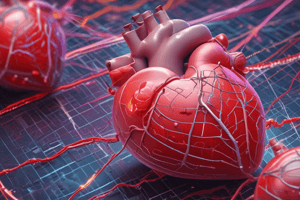Podcast
Questions and Answers
What are supraventricular arrhythmias?
What are supraventricular arrhythmias?
Abnormal heart rhythms that originate above the ventricles, most commonly in the atria.
Which of the following are types of supraventricular arrhythmias? (Select all that apply)
Which of the following are types of supraventricular arrhythmias? (Select all that apply)
- Multifocal Atrial Tachycardia (MAT) (correct)
- Atrial Fibrillation (AF) (correct)
- Premature Atrial Contractions (PACs) (correct)
- Atrial Flutter (AFL) (correct)
- Ventricular Tachycardia (VT)
What is the most common type of supraventricular arrhythmia?
What is the most common type of supraventricular arrhythmia?
Premature Atrial Contractions (PACs)
What can worsen Premature Atrial Contractions (PACs)?
What can worsen Premature Atrial Contractions (PACs)?
What is the PR interval duration characteristic of PACs on ECG?
What is the PR interval duration characteristic of PACs on ECG?
Do PACs require medication for management?
Do PACs require medication for management?
What is the heart rate of PV in the presented case?
What is the heart rate of PV in the presented case?
What was the rhythm disturbance observed in PV's ECG?
What was the rhythm disturbance observed in PV's ECG?
Study Notes
Supraventricular Arrhythmias Overview
- Supraventricular arrhythmias are abnormal heart rhythms originating above the ventricles, primarily in the atria.
- QRS complexes are usually narrow, indicating normal ventricular contraction despite the arrhythmia.
- Five common types include premature atrial contractions (PACs), atrial fibrillation (AF), atrial flutter (AFL), multifocal atrial tachycardia (MAT), and wandering atrial pacemaker.
- "Supraventricular tachycardia" (SVT) typically refers specifically to atrioventricular nodal reentrant tachycardia (AVNRT).
Premature Atrial Contractions (PACs)
- PACs are the most prevalent type of supraventricular arrhythmia, often perceived as extra heartbeats or “skipping a beat.”
- Generally considered the least dangerous arrhythmia type.
- Pathophysiology involves ectopic foci in the atria causing abnormal P waves on ECG.
- More frequent in patients with a history of myocardial infarction or structural heart disease.
Etiology of PACs
- Causes are mostly unknown; secondary factors include:
- Alcohol use
- Stimulant drugs (cocaine, amphetamines)
- Caffeine and tobacco consumption
- Increased occurrences may be noted during exercise or anxiety.
Diagnosis of PACs
- ECG shows wide, aberrant P waves differing from typical P waves, with a PR interval longer than 120 msec.
- PACs may be classified as conducting (followed by ventricular contractions) or non-conducting (not followed by ventricular contractions).
Management of PACs
- PACs often resolve spontaneously without medication intervention.
- Management suggests avoiding nicotine, alcohol, and caffeine to reduce frequency.
- Frequent PACs might indicate underlying structural heart disease, necessitating further evaluation.
Clinical Case Example
- A 64-year-old male with COPD experiences increased shortness of breath and an irregular heart rate of 110/min.
- ECG findings indicate a narrow QRS complex irregular rhythm with multiple P waves, requiring identification and treatment of his arrhythmia.
Studying That Suits You
Use AI to generate personalized quizzes and flashcards to suit your learning preferences.
Description
Explore the critical aspects of supraventricular arrhythmias in this workshop. Learn about their definitions, common types, and detailed insights into premature atrial contractions, including their etiology, clinical presentation, and ECG diagnosis. Enhance your understanding and management skills for these rhythm disorders.




